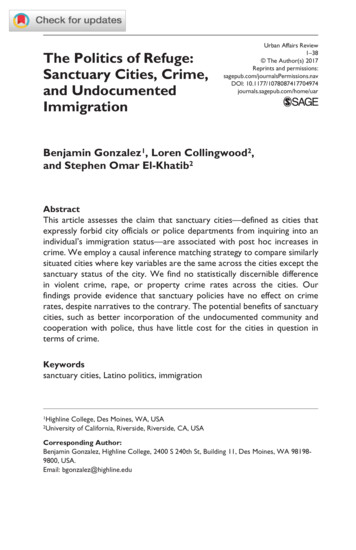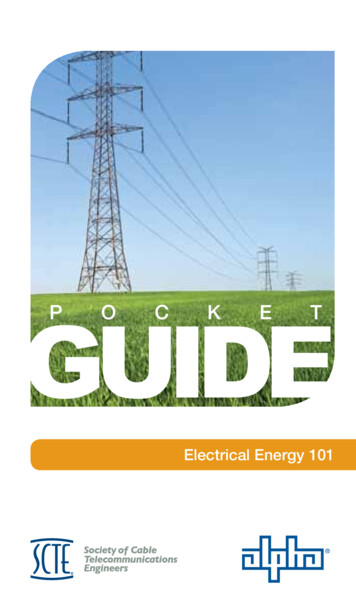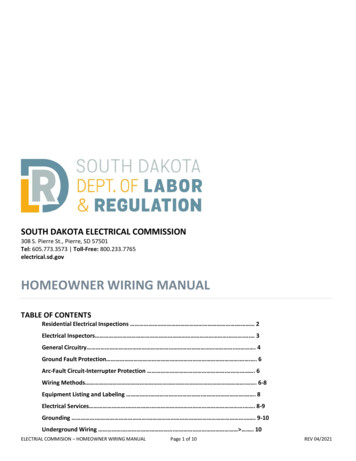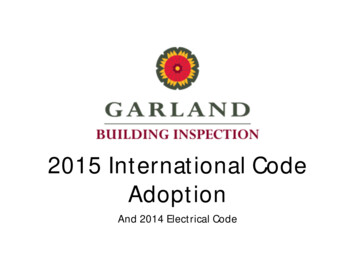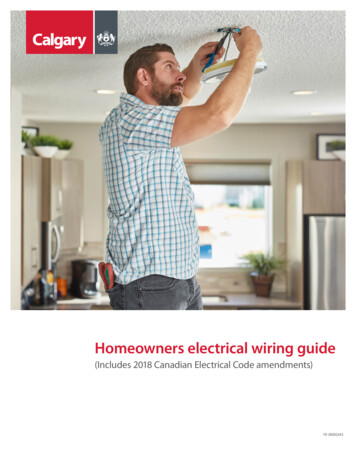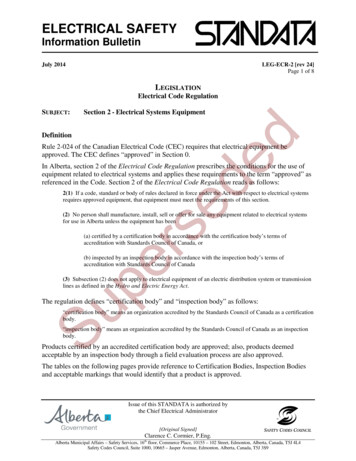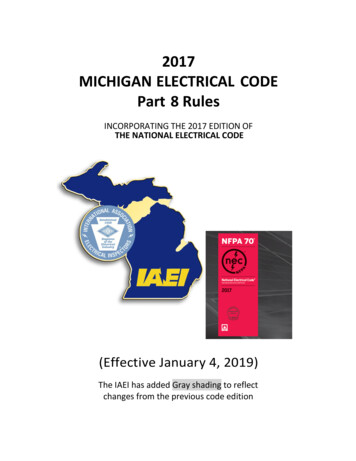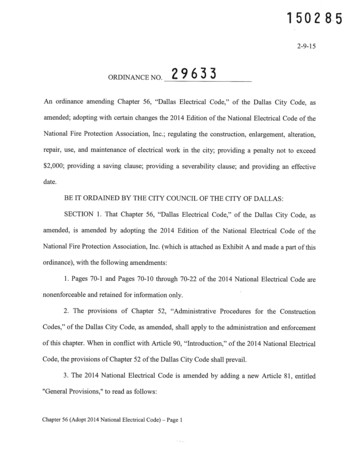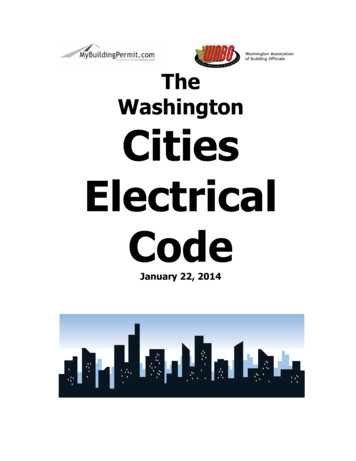
Transcription
TheWashingtonCitiesElectricalCodeJanuary 22, 2014
PREFACEIntroductionThe Washington Cities Electrical Code is a joint effort between theMyBuildingPermit.com (MBP) EGov portal and the Washington Association ofBuilding Officials (WABO). This Code was created to provide cities with adocument that complies with RCW 19.28.010(3), which allows cities to enforceany Ordinance that is equal, higher or better than the State’s rules, but offersthe following advantages. This Code omits all administrative and procedural State rules that citiescannot or choose not to adopt. This Code is written in the same format as the NEC to eliminate anyconflict between a State rule and the NEC. This format will also allowthe creation of insert pages that can be inserted into the applicablepages of the NEC. This Code provides enforcement consistency among those cities thatchoose to adopt it.DevelopmentThe partnership between MBP and WABO resulted in an Electrical Committeeopen to any Washington city and county wishing to participate. The ElectricalCommittee had participation from Bellevue, Bellingham, Burien, Des Moines,Kirkland, King County, Lacey, Longview, Marysville, Mercer Island, Olympia,Redmond, Renton, SeaTac, Seattle and Vancouver. The committee comparedthe 2014 NEC to the most current State rules and to any regional concerns andthrough consensus produced this Code. All Washington cities are encouragedto adopt this Code.MyBuildingPermit.comMyBuildingPermit.com (MBP) is an internet portal currently shared by 14 citiesand counties. Through the MBP portal, homeowners and contractors canobtain over the counter types of electrical, plumbing, mechanical and reroofpermits. Plans are under way to allow the submittal of plans electronicallythrough the MBP site.Other services provided through the MBP site include: Online inspection requests Current permit status1
Tip sheets for various construction issuesTraining opportunitiesThe member jurisdictions are dedicated to providing a consistent and efficientpermitting experience to their customers. The current members of MBP are,Bellevue, Bothell, Burien, Kenmore, Kirkland, Issaquah, Mercer Island, MillCreek, Newcastle, Renton, Sammamish, Snohomish County, Snoqualmie, andWoodinville .Washington Association of Building OfficialsThe Washington Association of Building Officials (WABO) was incorporated in1977 to promote building codes and standards that safeguard the public healthand safety; advise on legislative matters; assist in the development of nationaland state codes; provide educational opportunities for its members; andpreserve local government control of code administration.The WABO is a nonprofit, professional association of state, county, city andtown officials in Washington State engaged in the development, enforcementand administration of building construction codes and ordinances. Members(both governmental and associate) are building officials and inspectors,planners, architects, structural engineers and others interested in providingsafe buildings for our communities.FormatThis Code is divided into three parts to facilitate those cities that do not want toadopt the entire document. Part 1 adopts the 2014 NEC and other necessarycodes and standards adopted by the State. Part 2 is an administrative chapterbased on portions of the ICC Electrical Code, published by the InternationalCode Council. It provides necessary rules for enforcing and administering theNEC. Part 3 amends the NEC through supplements, deletions or revisions tobe equal, higher or better than the State’s rules. Only those Sections of theNEC that have been amended are included in this Code.2
Table of ContentsPart 1 AdoptionShort Title . . 6National Electrical Code and Standards Adopted . .6Conflicts . 6Part 2 AdministrationPurpose . 7Scope . . 7Applicability . . 8Moved Buildings . . 10Organization and Enforcement 12Permits and Fees . 14Construction Documents . 20Approval . 24Inspections and Testing . 26Service Utilities . 31Unsafe Systems and Equipment . 31Violations . 32Means of Appeals . 34Additional Electrical provisions 34Part 3 NEC 30.43230.70Examination of equipment for safety . 39Definitions . 39Approval . 49Examination, Identification, Installation, and Use of Equipment .49Mechanical Execution of Work . 50Flash protection . 51Identification of Disconnecting Means . 52Identification of Disconnecting Means .52Means of Identifying Grounder Conductors 53Ground Fault Circuit-Interrupter Protection for Personnel .53Branch Circuits Required . 53Arc-Fault Circuit-Interrupter Protection 54Ground-Fault Protection of Equipment . 54Lighting Loads for Specified occupancies 55Optional Calculations for Determining Existing Loads . 55Number of Supplies . 55Location . 56Service Mast Supports 56Wiring Methods for 600 Volts, Nominal, or Less 61Service Equipment – Disconnecting Means – General . 613
eArticleArticleArticleArticleArticle230.90Service Equipment – Overcurrent Protection . 62230.95Ground-Fault Protection of Equipment. . 62230.202 Service-Entrance Conductors . 63240.24Location on Premises – Not located over a step . 63250.28Main Bonding Jumper and System Bonding Jumper . 63250.50Grounding Electrode System . 64250.53Grounding Electrode System Identification . .64250.68Grounding Electrode Conductor and Bonding Jumper Connections . 64250.104 Bonding of Piping Systems and Exposed Structural Steel . 64250.184 Solidly Grounded Neutral Systems . 65300.11Securing and Supporting . 66310.110 Conductor Identification . 67314.23Supports 68334.15Exposed Work 68358.10Electrical Metallic Tubing: Type EMT - Wet Locations . 69358.12Electrical Metallic Tubing: Type EMT - Uses Not Permitted . 69394.12Concealed Knob-and-Tube Wiring - Uses Not Permitted 69406.12(D) Tamper Resistant Receptacles . 70410.10Bathtub and Shower Areas . 70410.62Cord-Connected Lampholders and Luminaires . 70422.10Branch-Circuit Rating . 71450.27Oil-Insulated Transformers Installed Outdoors 71450.42Walls, Roofs, and Floors 72501.200 Sewage Disposal Systems 72514.3Hazardous (Classified) Locations 74514.11Circuit Disconnects .74517.30Health Care Facilities - General Requirements .75519Education and Institutional Occupancies . 76525.1Carnivals, Circuses, Fairs, and Similar Events – Scope 77547.1Agricultural Buildings – Scope 77553.4Location of Service Equipment 77553.6Feeder Conductors 78553.7Installation of Services and Feeders 78555.1Marinas and Boatyards – Scope 78555.5Transformers .78555.7Location of Service Equipment . 79555.9Electrical Connections . 79555.10Electrical Equipment Enclosures 79555.13Wiring Methods and Installation 79555.19Receptacles . 79590.1Temporary Installations – Scope .80590.4General – Splices . 80600.3Electrical Signs and Outline Lighting – Listing . 80600.4Electrical Signs and Outline Lighting – Marking . 80600.10Portable or Mobile Signs . 81600.21(F) Ballasts, Transformers, and Electronic Power Supplies . 81600.30Electrical Signs and Outline Lighting – Applicability . .81680.4Approval of Equipment . .824
Article 680.13Article 680.25Article 680.40Article 680.70Article 690.2Article 690.4Article 690.7Article 700.5Article 700.7Article 700.10Article 700.12(B)Article 700.28Article 700.30Article 701.5Article 701.7Article 701.12Article 701.27Article 702.7Article 725.3(M)Article 760.3(L)Article 760.12Article 760.3(L)Article 770.3(D)Article 800.3(H)Article 800.30Field Installed Equipment . .82Feeders . .83Spas and Hot Tubs – General .83Hydromassage Bathtubs – General . 84Solar Photovoltaic Systems – Definitions . 84Solar Photovoltaic Systems – Installations . 84Solar Photovoltaic Systems – Maximum Voltage . 84Emergency Systems - Transfer Equipment . 85Emergency Systems – Signs 85Wiring Emergency Systems . 86Emergency Systems – Sources of Power . 87Coordination 88Smoke Control Systems - Pressurization Wiring and Equipment .88Transfer Equipment . 88Legally Required Standby Systems – Signs 89Legally Required Standby Systems . 89Coordination 89Optional Standby Systems – Signs . 90Class 1, Class 2, and Class 3 Circuits - Other Articles . 90Other articles – Suspended Ceilings 90Amended – Fire Alarm Systems .90Fire Alarm Circuit Identification . 91Optical Fiber Cables and Raceways – Other Articles .91Communication Circuits – Other Articles . 92Communication Circuits – Network Demarcation Point .925
Part 1 - Adoption80National Electrical Code Article 80 created — Adoption.The National Electrical Code is amended and supplemented by the addition of anew Article to be known as Article 80 – Adoption, to read as follows:Article 80Adoption80.1 Short Title. These regulations shall be known as the City ElectricalCode and shall be cited as such and will be referred to herein as “thiscode.”80.3 National Electrical Code and Standards Adopted. The 2014Edition of the National Electrical Code (NFPA 70), including Annex A, B andC; Commercial Building Telecommunications Cabling Standard(ANSI/TIA/EIA 568 C series, February 2009 Commercial Building Standardfor Telecommunications Pathway and Spaces (ANSI/TIA/EIA 569 B, October2014); \ Commercial Building Grounding and Bonding Requirements forTelecommunications (ANSI/ TIA/EIA 607-B, August 2011); and theResidential Telecommunications Cable Standard (ANSI/TIA/EIA 570-B2004);and the National Electrical Safety Code (NESC C2-2012 excludingAppendixes A and B) are adopted and shall be applicable within the city, asamended, added to and excepted in this code.The National Electrical Code will be followed where there is any conflictbetween the National Electrical Code and ANSI/TIA/EIA 569-B,ANSI/TIA/EIA570-B, or the NESC C280.4 Conflicts. In accordance with RCW 19.28.010(3), where the State ofWashington, Department of Labor and Industries adopts a more currentedition of the National Electrical Code (NFPA 70) the Code Official maysupplement use of this Code with newly adopted editions of the NationalElectrical Code.6
Part 2 - Administration85National Electrical Code Article 85 created —Administration.The National Electrical Code is amended and supplemented by the addition of anew Article to be known as Article 85 – Administration, to read as follows:Article 85Administration85.1 Purpose. The purpose of this code is to provide minimum standardsto safeguard life or limb, health, property and public welfare by regulatingand controlling the design, construction, installation, quality of materials,location, operation, and maintenance or use of electrical systems andequipment.85.3 Scope. This code covers the installation of electric conductors,electric equipment and additions, alterations, modifications, or repairs toexisting electrical installations for the following:(A) Electric conductors, electric equipment, and electrical racewaysinstalled within or on public and private buildings, property or otherstructures.(B) Signaling and communications conductors and equipment,telecommunications conductors and equipment, fiber optic cables, andraceways installed within or on public and private buildings, property orother structures.(C) Yards, lots, parking lots, and industrial substations.(D) Temporary electrical installations for use during the construction ofbuildings.(E) Temporary electrical installations for carnivals, conventions, festivals,fairs, traveling shows, the holding of religious services, temporarylighting of streets, or other approved uses.(F) Installations of conductors and equipment that connect to a supplyof electricity.(G) All other outside electrical conductors on the premises.(H) Optional standby systems derived from portable generators.Exception: Installations under the exclusive control of electric utilities forthe purpose of communication, transmission, and distribution of electricenergy located in buildings used exclusively by utilities for such purposes7
or located outdoors on property owned or leased by the utilities or onpublic highways, streets, roads, etc., or outdoors by established rights onprivate property.It is the intent of this section that this code covers all premises’ wiringor wiring other than utility owned metering equipment, on the load sideof the service point of buildings, structures, or any other premises notowned or leased by the utility. Also, it is the intent that this code coversinstallations in buildings used by the utility for purposes other than listedin above, such as offices buildings, warehouses, garages, machine shops,and recreational buildings which are not an integral part of a generatingplant, substation, or control center.85.5 Applicability(A) New Installations. This code applies to new electrical installations.Exception: If an electrical permit application is received after this chapterhas taken effect, but is associated with a building permit applicationreceived prior to the effective date of the ordinance codified in this chapter,all applicable codes adopted and in force at the time of a complete buildingpermit application will apply.(B) Existing installations. Lawfully installed existing electricalinstallations that do not comply with the provisions of this chapter shall bepermitted to be continued without change, except as is specifically coveredin this code, the International Fire Code or as is deemed necessary by thebuilding official for the general safety and welfare of the occupants and thepublic. Where changes are required for correction of hazards, a reasonableamount of time shall be given for compliance, depending on the degree ofthe hazard.(C) Maintenance. Electrical systems, equipment, materials andappurtenances, both existing and new, and parts thereof shall bemaintained in proper operating condition in accordance with the originaldesign and in a safe, hazard-free condition. Devices or safeguards that arerequired by this code shall be maintained in compliance with the codeedition under which installed. The owner or the owner’s designated agentshall be responsible for the maintenance of the electrical systems andequipment. To determine compliance with this provision, the code officialshall have the authority to require that the electrical systems andequipment be re-inspected.(D) Additions, alterations, modifications or repairs. Additions,alterations, modifications or repairs to the electrical system of any building,8
structure, or premises shall conform to the requirements of this codewithout requiring those portions of the existing building not being altered ormodified to comply with all the requirements of this code. Installations,additions, alterations, modifications, or repairs shall not cause an existingbuilding to become unsafe or to adversely affect the performance of thebuilding as determined by the building official or designated representative.Electrical wiring added to an existing service, feeder, or branch circuit shallnot result in an installation that violates the provisions of the code in forceat the time the additions were made.(E) Change in occupancy. It shall be unlawful to make a change in theoccupancy of any structure that will subject the structure to any specialprovision of this code applicable to the new occupancy without approval.The code official shall certify that such structure meets the intent of theprovisions of law governing building construction for the proposed newoccupancy and that such change of occupancy does not result in anyhazard to public health, safety or welfare.(F) Differences.(1) Where, in any specific case, different sections of this code specifydifferent materials, methods of construction or other requirements, themost restrictive shall govern. Where there is a conflict between ageneral requirement and a specific requirement, the specific requirementshall be applicable.(2) The requirements of this code will be observed where there is anyconflict between this code and the National Electrical Code (NFPA 70),Centrifugal Fire Pumps (NFPA 20), the Emergency and Standby PowerSystems (NFPA 110), ANSI/TIA/EIA 568-B, ANSI/TIA/EIA 569-A,ANSI/TIA/EIA 607, or ANSI/TIA/EIA 570.(3) The National Electrical Code will be followed where there is anyconflict between standard for Installation of Stationary Pumps for FireProtection (NFPA 20), standard for Emergency and Standby PowerSystems (NFPA 110), ANSI/TIA/EIA 568-B, ANSI/TIA/EIA 569-A,ANSI/TIA/EIA 607, ANSI/TIA/EIA 570-B, and the National ElectricalCode (NFPA 70).(G) Other laws. The provisions of this code shall not be deemed to nullifyany provisions of local, state or federal law.(H) Validity. In the event any part or provision of this code is held to beillegal or void, this shall not have the effect of making void or illegal any ofthe other parts or provisions thereof, which are determined to be legal; andit shall be presumed that this code would have been adopted without suchillegal or invalid parts or provisions.9
(I) Segregation of invalid provisions. Any invalid part of this code shallbe segregated from the remainder of this code by the court holding suchpart invalid, and the remainder shall remain effective.(J) Application of references. References to chapter or section numbers,or to provisions not specifically identified by number, shall be construed torefer to such chapters, sections or provisions of this code.(K) Referenced codes and standards. The codes and standardsreferenced in this code shall be considered part of the requirements of thiscode to the prescribed extent of each such reference. Where differencesoccur between provisions of this code and referenced codes or standards,the provisions of this code shall apply.Exception: Where enforcement of a code provision would violate theconditions of the listing of the equipment or appliance, the conditions of thelisting and manufacturer’s instructions shall apply.(L) Annex Chapters Provisions in the annex chapters shall not applyunless specifically referenced in the adopting ordinance.(M) Subjects not regulated by this code. Where no applicablestandards or requirements are set forth in this code, or are contained withinother laws, codes, regulations, ordinances or bylaws adopted by thejurisdiction, compliance with applicable standards of nationally recognizedstandards as are approved shall be deemed as prima facie evidence ofcompliance with the intent of this code. Nothing herein shall derogate fromthe authority of the code official to determine compliance with codes orstandards for those activities or installations within the code official’sjurisdiction or responsibility.85.9 Moved buildings or structures.(A) Buildings or structures intended to be relocated within or into the citymust be inspected by the code official for compliance with the codes andstandards adopted in this chapter prior to being relocated or moved. Theowner of the building or structure must obtain a building permit and furthermust agree to correct all deficiencies identified by the inspection prior tomoving the building. All deficiencies must be corrected before electric poweris connected to the building.(B) Nonresidential buildings or structures moved into the jurisdiction mustbe inspected to ensure compliance with current requirements of this Code.(C) Residential buildings or structures wired in the U.S., to NECrequirements, and moved into the jurisdiction must be inspected to ensurecompliance with the NEC requirements in effect at the time and place theoriginal wiring was made. The building or structure must be inspected to10
ensure compliance with all current requirements of chapter 19.28 RCW andthe rules developed by the department if:(1) The original occupancy classification of the building or structure ischanged as a result of the move; or(2) The building or structure has been substantially remodeled orrehabilitated as a result of the move.(D) Residential buildings or structures wired in Canada to CanadianElectrical Code (CEC) standards and moved into the jurisdiction must beinspected to ensure compliance with the following minimum safetyrequirements:(1) Service, service grounding, and service bonding must comply withthis Code.(2) Canadian Standards Association (CSA) listed Type NMD cable isallowed with the following qualifications:(a) CSA listed Type NMD cable, American Wire Gauge #10 andsmaller installed after 1964 utilizing an equipment groundingconductor smaller than the phase conductors, must be:(i) Replaced with a cable utilizing a full-size equipment groundingconductor; or(ii) Protected by a ground fault circuit interrupter protectiondevice.(b) CSA listed Type NMD cable, #8 AWG and larger, must:(i) Utilize an equipment grounding conductor sized according tothe requirements of the NEC in effect at the time of theinstallation;(ii) Be protected by a ground fault circuit interrupter protectiondevice; or(iii) Be replaced.(3) Other types of wiring and cable must be:(a) Replaced with wiring listed or field evaluated in accordance withU.S. standards by a laboratory approved by the department; or(b) Protected by a ground fault circuit interrupter protection deviceand arc fault circuit protection device.(4) Equipment, other than wiring or panelboards, manufactured andinstalled prior to 1997 must be listed and identified by laboratory labelsapproved by the department or CSA labels.(5) All panelboards must be listed and identified by testing laboratorylabels approved by the department with the following qualifications:(a) CSA listed panelboards labeled "Suitable for Use as ServiceEquipment" will be considered to be approved as "Suitable for Useonly as Service Equipment."(b) CSA listed panelboards must be limited to a maximum of 42circuits.11
(c) CSA listed panelboards used as lighting and appliancepanelboards as described in the NEC, must meet all currentrequirements of the NEC and this chapter.(6) Any wiring or panelboards replaced or changed as a result of themove must meet current requirements of chapter 19.28 RCW and thischapter.(7) The location, type, and ground fault circuit interrupter protection ofreceptacles and equipment in a bathroom, kitchen, basement, garage,or outdoor area must meet the Washington requirements in effect at thetime the wiring was installed.(8) 4, 15-ampere, kitchen small appliance circuits will be accepted in lieuof 2, 20-ampere, kitchen small appliance circuits. Receptacles will not berequired to be added on kitchen peninsular or island counters.(9) Spacing requirements for all other receptacles must meet theWashington requirements in effect at the time the wiring was installed.(10) Receptacles installed above baseboard or fixed wall space heatersmust be removed and the outlet box covered with a blank cover. Thereceptacle is required to be relocated as closely as possible to theexisting location.(11) Lighting outlet and switch locations must meet the Washingtonrequirements in effect at the time the wiring was installed.(12) Dedicated 20-ampere small appliance circuits are not required indining rooms.(13) Electric water heater branch circuits must be adequate for the load.(14) The location, type, and circuit protection of feeders must meet theWashington State requirements in effect at the time the wiring wasinstalled.85.11 Organization and Enforcement(A) Creation of enforcement agency. The department of electricalinspection is hereby created and the official in charge thereof shall beknown as the code official. The function of the department shall be to assistthe code official in the administration and enforcement of the provisions ofthis code.(B) Appointment. The code official shall be appointed by the chiefappointing authority of the jurisdiction.(C) Deputies. In accordance with the prescribed procedures of thisjurisdiction and with the concurrence of the appointing authority, the codeofficial shall have the authority to appoint a deputy code official, the relatedtechnical officers, inspectors, plans examiners and other employees. Suchemployees shall have powers as delegated by the code official.12
(D) Duties and powers of the code official. The code official is herebyauthorized and directed to enforce the provisions of this code. The codeofficial shall have the authority to render interpretations of this code, and toadopt policies, procedures, rules and regulations in order to clarify theapplication of its provisions. Such interpretations, policies, procedures, rulesand regulations shall be in compliance with the intent and purpose of thiscode. Such policies and procedures shall not have the effect of waivingrequirements specifically provided for in this code.(1) Rule-making authority. The code official shall have authority asnecessary in the interest of public health, safety and general welfare, toadopt and promulgate rules and regulations and to designaterequirements applicable because of local climatic or other conditions.Such rules shall not have the effect of waiving requirements specificallyprovided for in this code, or of violating accepted engineering methodsinvolving public safety.(2) Applications and permits. The code official is authorized toreceive applications, review construction documents and issue permitsfor the installation of electrical systems and equipment, inspect thepremises for which such permits have been issued, and enforcecompliance with the provisions of this code.(3) Notices and orders. The code official is authorized to issue allnecessary notices or orders in accordance with Section 85.25(B) as arerequired to effect compliance with this code.(4) Inspections. The code official shall make all of the inspectionsnecessary to determine compliance with the provisions of this code inaccordance with Section 85.19.(5) Identification. The code official shall carry proper identification asrequired by Section 85.19(G).(6) Right of entry. The code official is authorized to enter thestructure or premises at reasonable times to inspect or perform theduties imposed by this code in accordance with Section 85.19(I).(7) Department records. The code official shall keep official recordsof applications received, permits and certificates issued, fees collected,reports of inspections, notices and orders issued, and as required by thiscode, such records shall be retained in the official records for the periodrequired for retention of public records.(8) Approvals and modifications. A record of approvals andmodifications granted shall be maintained by the code official and shallbe available for public inspection during business hours in accordancewith applicable laws.13
(9) Inspections. The code official shall keep a record of eachinspection made, including notices and orders issued, showing thefindings and disposition of each.(10) Alternative methods or materials. The application formodification, alternative methods or materials and the final decision ofthe code official shall be in writing and shall be officially recorded in thepermanent records of the code official.(11) Liability. The code official, officer or employee charged with theenforcement of this code, while acting for the jurisdiction in good faithand without mali
Code and shall be cited as such and will be referred to herein as "this code." 80.3 National Electrical Code and Standards Adopted. The 2014 Edition of the National Electrical Code (NFPA 70), including Annex A, B and C; Commercial Building Telecommunications Cabling Standard (ANSI/TIA/EIA 568 C series, February 2009 Commercial Building Standard


